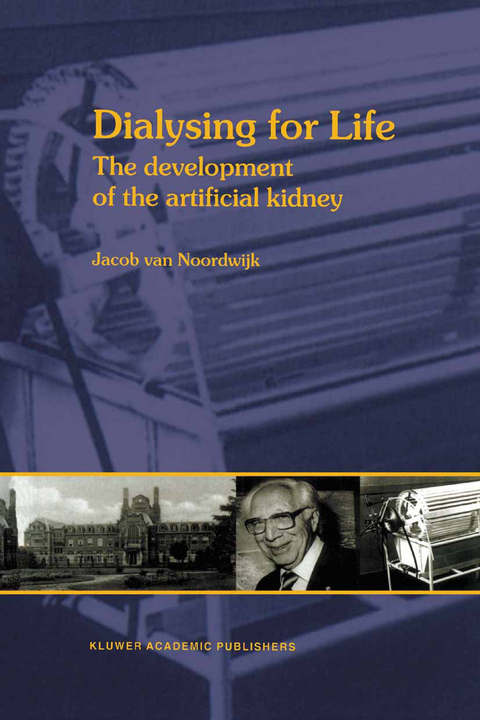
Dialysing for Life
Springer (Verlag)
978-0-7923-6840-3 (ISBN)
Seeing a patient die under his hands because there is no adequate treatment causes an emotion and a frustration in a doctor, which sometimes stimulates him to try to develop a new type of treatment. Seeing so many wounded young soldiers die due to renal failure in World War I incited the German doctor Georg Haas to try to develop an artificial kidney. He had to give up in despair in 1928.
Ten years later doctor Willem Kolff saw a young man die in his ward in the University Hospital of Groningen due to renal failure. By that time two essential factors for an artificial kidney had become available: a drug to keep the blood from clotting outside of the body and an efficient dialysing membrane through which waste substances can pass from the blood into the dialysing fluid. Kolff succeeded in creating the rotating artificial kidney which he started using in the town hospital of Kampen in 1943. The rotation of this artificial kidney started a revolution that made it possible for thousands of kidney patients all over the world to keep on living - and sometimes to forget their disease for the time being. In addition it gave rise to the development of other artificial organs such as the heart-lung machine, the artificial heart and the artificial eye.
Doctor Jacob van Noordwijk, the author of this book, was Kolff's first assistant in the treatment of the first 15 patients. How Kolff succeeded in spite of all the limitations imposed by the German occupation of the Netherlands and in spite of the absence of antibiotics and other medical tools which are common nowadays makes a story which may sound incredible. Yet it did happen and visitors to the town of Kampen can still see the hospital building where it all took place.
1. The first dialysis in 1943.- 2. The prelude to the first dialysis in 1943.- 2.1 Why Dr Kolff wished to develop an artificial kidney.- 2.2 The search for a serviceable artificial kidney.- 2.3 The May days of 1940.- 2.4 To Kampen: the artificial kidney becomes a reality.- Notes.- 3. Step by step toward s a robust machine.- 3.1 Towards a continuous perfusion.- 3.2 The yield of the dialysis.- 3.3 Protection of erythrocytes during dialysis.- 4. In the meantime the war went on.- 4.1 All the things we did not have.- 5. The first series of 17 patients.- Notes.- 6. The second and third artificial kidney.- 6.1 Technical developments in the apparatus.- 6.2 The first kidney goes to The Hague.- 6.3 The third kidney goes to Amsterdam.- Notes.- 7. Hibernation of the kidney 1944–1945.- Notes.- 8. Recognition at home and abroad.- Notes.- 9. New ways of fighting uraemia.- 9.1 Peritoneal dialysis.- 9.2 Intestinal perfusion.- 9.3 Non-rotating artificial kidneys.- 9.4 Dietary reduction of protein breakdown.- Notes.- 10. Breathing with a kidney.- 11. The kidney in Canada and the USA.- 11.1 The artificial kidney in Montreal.- 11.2 The artificial kidney in London, Ontario.- 11.3 Sire of ‘kidney’ is Frankfurter: a leech also helped.- 11.4 Frustration in Cleveland.- 11.5 The twin-coil kidney, suitable for mass production.- 11.6 The artificial kidney in Boston.- 11.7 The Department of Artificial Organs at the University of Utah.- Notes.- 12. The place of the artificial kidney in present-day medicine — and how it was achieved.- 12.1 The accessibility of the patient’s blood vessels for repeated dialysis.- 12.2 Home dialysis.- 12.3 Renal transplantation.- 12.4 The 1972 legal regulation for reimbursement.- 12.5 The technical evolution of the artificial kidney.- 12.6 Does the clinicianmake an effective use of what is technically available?.- Notes.- 13. Renal dialysis in the Netherlands and in Europe.- 13.1 Renal dialysis in the Netherlands.- 13.2 Renal dialysis in Europe.- 13.3 Renal dialysis in the holidays.- Notes.- 14. On the shoulders of Kolff.- Notes.- 15. Has Kolff reached his goal?.- 16. A new life for old dialysers.
| Erscheint lt. Verlag | 31.3.2001 |
|---|---|
| Zusatzinfo | XII, 114 p. |
| Verlagsort | Dordrecht |
| Sprache | englisch |
| Maße | 160 x 240 mm |
| Themenwelt | Geisteswissenschaften ► Geschichte |
| Medizinische Fachgebiete ► Innere Medizin ► Nephrologie | |
| Studium ► Querschnittsbereiche ► Prävention / Gesundheitsförderung | |
| ISBN-10 | 0-7923-6840-1 / 0792368401 |
| ISBN-13 | 978-0-7923-6840-3 / 9780792368403 |
| Zustand | Neuware |
| Haben Sie eine Frage zum Produkt? |
aus dem Bereich


